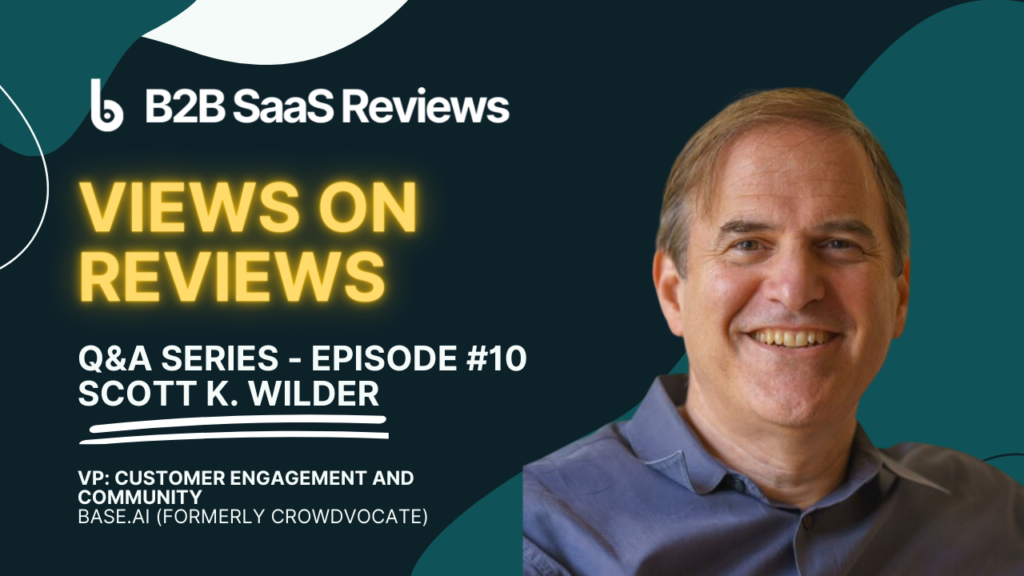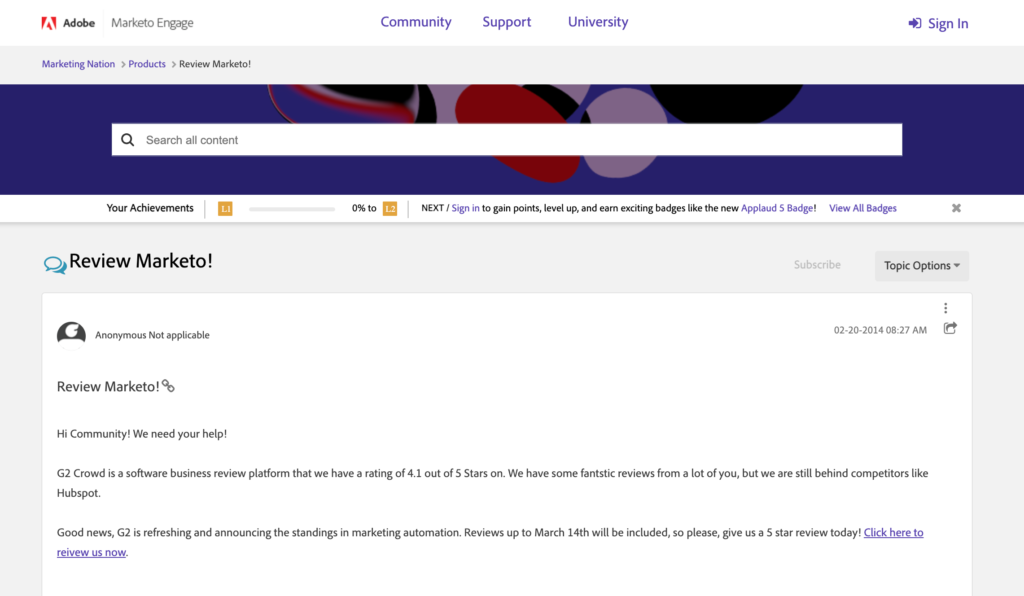Views on Reviews is a new series of interviews with B2B SaaS professionals who will provide a real-world perspective on what it’s like working on reviews. My tenth interview is with Scott K. Wilder, VP: Customer Engagement and Community at Base.ai (Formerly Crowdvocate).

Scott K. Wilder is the VP: Customer Engagement and Community at Base, a customer marketing and advocacy platform. He’s an Advisor, Mentor, and Top25CMA Influencer in Customer Engagement, Growth Marketing and Online Community. Ex-HubSpot, Marketo, Adobe, Intuit, Google, Udacity, and Coursera, Scott has a wealth of knowledge to share.
Scott’s known by his peers and colleagues as accomplishing some impressive feats:
- A dynamic and innovative digital leader…he led multiple cross-functional teams in building out Marketo’s 60,000 strong customer evangelists.
- Scott was the pioneer of Intuit community team. Before Intuit management started planning a social strategy, Scott was already foreseeing the social trend. The very successful QuickBooks community site and moderator team were Scott’s brainchild.
- Scott led HubSpot’s Community team that doubled membership and increased activation and engagement 3x during his tenure by implementing innovative programs fusing education, community and advocacy
As Scott likes to say, it’s time to take a walk on the wilder side. Let’s get Scott’s views on reviews.
1. You've led customer engagement, growth marketing, and online communities for the who's who of SaaS: HubSpot, Marketo, Adobe, Intuit, Google, Udacity, and Coursera. In these roles, how have you approached user reviews?
As we (should) know from Industry data – Customer Reviews should be a key play in the Customer Engagement and Customer Marketing playbook. And yet, many of the companies I have worked at do not give them the TLC they deserve.
When I have been in leadership positions, I have tried to get teams to prioritize them. Where do they stack among everything else? Definitely in the top 3-4 areas.
There is so much you can do with them from a “marketing” perspective and a learning perspective. Concerning the former, they are key for top-of-the-top funnel activities and, in some ways, are becoming more important than the initial outbound sales reps’ cold call. From a learning perspective – you can learn more about a company’s marketing and sales technology stack, you can gain insights into how their pain points of JTBD (Jobs To Be Done) and more.
2. When you were at HubSpot, you presented how to sell community to management. Do you see these selling points working for selling reviews to management, too?
Some recommendations:
- Share industry data about how customers use customer and user reviews more. This data is readily available at G2, TrustRadius and other sites. Here are examples of the type of data they share
- 92% of B2B buyers are more likely to purchase after reading a trusted review.
- 89% of B2B researchers use the internet during the B2B research process.
- 64% of software buyers want to read at least six reviews before making a purchase
- Show what the competition is doing and ask management if they want to be in the same discussions as our competitors.
- Create ‘the imagine slide’ – and show management what the impact can be.
- Present and partner with internal stakeholders, whether they are net promoters of your programs or naysayers. Why naysayers – you want to understand the POV of the people who will put up the most resistance in the organization. When I was at Intuit, and we asked for a budget, I actually offered to partner with legal and privacy when I met with the CEO and his direct reports. I figured they would be the most concerned about what happens when someone says something negative about the company on our own websites and non-owned properties. Interesting story. When we presented to the CEO, and his direct reports, the head of corporate communications expressed his concerns about having employees on social media and posting in our own community (this was back in 2005). Intuit’s CEO and Founder responded by asking this person why they would hire someone they didn’t have confidence in to do the right thing and post constructive information.
- Keep them up-to-date: It is important to keep all your stakeholders informed on how your programs are doing, and this can be done with weekly updates via email and monthly or quarterly Zoom or in-person meetings.
At our webinar, we asked Scott Wilder, Head of Customer Engagement & Community at Hubspot – how to sell community to management by communicating the value that customer engagement adds to a company? Check out what Scott had to say 🗣️ pic.twitter.com/1HMNnCBgzG
— Base B2B Customer-led Growth (ex Crowdvocate) (@Base_CLG) November 11, 2021
3. A recurring theme in Views on Reviews is a rise in buyers turning to the community for B2B SaaS buying decisions. What's your take on this trend? How do you think communities can better serve buyers seeking information from their peers using the software they're considering?
Buyers turning to the community for B2B SaaS buying decisions has always been the case in my experience – that members of an ecosystem go to either an owned (branded) community or to a non-owned community such as a Slack Channel or Reddit, etc. to ask product questions and get advice about purchasing a new product or service.
So there are a couple of things Communities can do:
- Enable members to score or provide feedback on the person providing the reviews. This can be as simple as marking something helpful or more involved such as building a trigger to reach out to the person who asked the question or got advice three months later or so and ask them if they purchased the product and if the advice they got from the Community was helpful.
- Provide as much information about the person making the recommendation or providing advice as possible. The potential buyer needs to know where the other person is coming from and their background. Were they the admin of a product? Were they just an end user? What industry do they work in, etc. All of this is valuable information. When I built a Live Community (a continuous discussion thread inside the product) at Intuit, we connected ‘answer people’ with customers inside the product. We ensured that the person who asked the question knew everything they could about the person providing advice.
4. You tweeted, "Social proofs like any review or testimonial adds a human element to your brand experience." Why is it important to add this human element to a brand experience?
Social proofs like any review or testimonial adds a human element to your brand experience.#feedback #testimonial #brandExperience #branding #CustomerExperience #socialmediamarketing #marketingstrategy #Review #Ratings pic.twitter.com/roU3Bsw2fT
— Wilder (@skwilder) August 18, 2021
We are human beings, after all. I think sometimes we forget the importance of the emotional element and the connection needed to give something more credibility. There’s been lots of research in this area – For example, the impact of showing a photo vs artwork/painting of someone; the photo increases conversion rates (of course, it’s got to be an authentic photo).
But the human element involves more than pictures. It also consists of the language used. The reader will identify with the person posting more, and the content will be more believable if it is written similarly to the reader’s speech. One of the significant advantages of a common language is that the shared understanding associated with it means that people know not just what it means but how they are expected to react to it. It accelerates the connection and, thus the understanding between two people. Not sure why so few marketers spend time working on the language used in their communications.
By the way, at Marketo, we used to test out different marketing messages in the Community, and when we did this, we focused a great deal on testing out tone and voice.
5. You also tweeted, "Potential consumers are more inclined to choose your business for their requirements if they see that you have a high rating, favourable reviews, and respond professionally to any concerns." What advice would you give to a B2B SaaS customer marketer looking to run a successful online reputation management campaign?
Potential consumers are more inclined to choose your business for their requirements if they see that you have a high rating, favorable reviews, and respond professionally to any concerns.#digitalmarketing #DigitalMarketingtips #MarketingDigital #OnlineMarketing #marketing pic.twitter.com/MMkJEKC3BK
— Wilder (@skwilder) September 20, 2021
I forget where and when I said that – but I will go back into the Wilder and Twitter archives and see what I can find…
A couple of thoughts come to mind:
First, if you are going to highlight third-party reviews on your site, just don’t cut and paste those 5 star ones. If they are all 5 stars, people will question the authenticity of the reviews. After all, no software product is perfect.
Secondly, it shows you care about the customer if you respond directly to them on your site or on a review site. It baffles me how many companies don’t respond to what people post on review sites. Yes, it takes time, but at the end of the day, how can you be a customer-first company if you don’t at least acknowledge that you are listening and then demonstrate that you understand the other person’s pain point.
6. You mentioned that you're seeing a shift in responsibility for generating reviews from a cross-functional effort to one consolidated in the Customer Marketing function. What do you think is driving this shift?
Historically, retention activities were dispersed across the organization. In the last two years, they have consolidated more under customer marketing. Especially when it comes to 1-to-many marketing plays. Since Customer Marketing is leading these types of engagements, they are learning how to operationalize customer-first programs across the organization. This gives them tremendous insights into partnering with and leading other organizations that interact with the customer. The key, however, is that these engagements are team initiatives. Customer marketing is facilitating and helping organizations establish seamless and integrated programs.
7. You also mentioned that Customer-led functions don't speak with one another as much as they should, and that part of the reason is that it's tough to move organizations and share metrics cross-functionally. Can you elaborate on how customer-led functions could work more together on something like review generation?
As you might have heard me say earlier, I leaned into Product Led Growth in 2014, and I learned the power of small cross-functional teams with what Amazon calls single-threaded focus.
At Adobe, this came into play when a leader took six of us from different parts of the organization and put us in a room (this was pre-covid) and told us to solve what was called the first-mile problem – which at the time was defined as the first 30 days someone has Adobe LightRoom. Six of us were told to improve L1, L7, L30 (the first 30 days someone had a product). We could not reach out to others in the org – and eventually, we focused on L1, the first 24 hours, someone had LightRoom. We were dramatically able to increase activation, which also positively impacted retention. This Adobe experience taught me about the importance of working together.
So, when it comes to reviews, I would create a small team to work together on building out a successful review program. It could be two people – the product marketing person and a customer marketer. The bottom line is that they both own this initiative.
8. I found a 2014 Marketo Nation post on reviews from when you were at Marketo (or just before you joined). The post asked the Marketo community to write G2 reviews to help surpass HubSpot and other competitors in the G2 standings for marketing automation. Any tips on how to get reviews through community posts like this? (E.g. share how your user's review will help grow the community (by surpassing HubSpot in the G2 rankings).
Yikes. And that was during my tenure at Marketo. I probably would not approach a review that way today, and I am hoping that if I had caught this post back in 2014, I would have coached the employee who posted it on how to handle things differently. (Nobody’s perfect, so I would try and make it a teachable moment: )
I tend to look to the past only to guide me. As Steve Jobs said, “you can’t connect the dots looking forward; you can only connect them looking backward.”
To answer your question, I would discourage this post because you never know if you will work for the competitor, which I did – after all, I ended up working at HubSpot.
Secondly, don’t make your post about the competitor. Make it about helping build awareness about the product and seeing if the person posting is interested in building their brand by posting a review site.
So, in sum, if I could go back in time, I would have encouraged the person posting to position as ‘we are building a marketing nation (the name of Marketo’s Community) and that by posting on G2 or TrustRadius they are helping build out The (Marketo) Nation.
9. One of your 10 Rules for Successful Communities is that only 5-10% of your users will sign up for your community. Have you found that it's similar to reviews? (I.e. only 5-10% of users will give a review)
I have seen similar numbers for Customer Reviews in different reports. I can only speak about B2B SaaS companies’ review numbers.
I believe it is probably a little bit higher than 10% these days because:
a) today, people are more inclined to share their opinions online than they were just a few years ago,
b) younger generations are also more inclined
c) reviews are slowly happening outside of the G2, TrustRadius and PeerSpot sites. For example, I see people writing reviews about their experiences with B2B products on LinkedIn.
10. What have you found works—and what doesn't—in review generation (when asking for reviews)?
What works:
- Patience: Give your customer some time to learn and use your product (some companies ask for reviews too early in the customer’s journey) So you need to wait a while until you ask the customer to write a review about your product or service
- Patience again: Remind management that getting a zillion reviews overnight is difficult. First, you have to have the right number of customers. If you have 100 customers, you will not get 100 reviews, and you might not even get half of that or a quarter of that. But with your customers, tell management that it takes time to build up reviews. This leads me to the next point
- Mindful (I am from California, so I will use that word). Spread out your asks for reviews because you want to avoid a lot of reviews appearing at once and then not have any more customers to ask for reviews later on.
- Singles and doubles can be better than home runs: People will be skeptical if you get all 5-star review ratings. I did see some places where people believe 4 and 3-star reviews more than 5 star reviews.
- Transparency: Be clear and honest about what you are asking for and why you are asking for it.
- Relevancy: If you want to reward the person writing the review, find out what’s important to them and what they would want for the review, which at the end of the day, might be nothing
What doesn’t work:
- Not reading or responding to reviews. Make sure to follow up reviews about your product and respond to negative and positive reviews. (Set aside an hour or so every two weeks to read and respond to reviews)
- Only focus on reviews a few times a year. Like a garden, you need to nurture your customer base and keep an eye on what’s happening on review sites.
- Think only about text-based reviews. Guess what? Video reviews are coming on strong in 2023.
- Not leveraging reviews in your marketing materials. Many companies will ask a customer for a testimonial but not check review sites first to see if there is any good info.
- Trying to boil the whole ocean at once. Focus on 1-2 review sites at first.
11. On your list of objectives for your customer marketing programs, where do reviews rank on your list? Is it a top priority? If it varies, what causes your prioritization to vary?
Reviews rank high on my list in the customer marketing world.
It not only gives me insight into what customers like and don’t like about our products and our competitors’ products (as well as products in other segments), it also gives me the name of someone I can reach out to and learn more about them.
When I have managed these programs in the past, I have reached out to the person writing the review and requested a one on one discussion so I can learn more about them, their JTBD (the jobs they want to accomplish with our product), the other items in their environment and finally, what’s important to them – career wise.
Each interaction allows me to learn and share those learnings with my coworkers.
12. What was your favorite review request campaign?
A simple approach which has worked for me includes:
- Don’t ask for a review until someone has used your product for at least 6 months.
- Ask the person writing the review what they would like.
- Offer them something besides SWAG and Amazon GCs.
- Offer them the option of a MasterClass course or some other type of learning.
13. Have you used buyer intent data from review sites? If so, how?
Most customer marketers I speak to are not 100% sure what buyer intent data is, so if it is ok with you, I would like to define it here.
Buyer Intent Data “is a set of behavioral data points based on actions, completing a download, indicating someone may be interested in buying your product.”
So in the past, I have leveraged data from TrustRadius and G2 and other review sites to do more sophisticated segmentation, which then can be used for creating personalized experiences.
I could use the data to develop the ideal customer profile and then use that information to target messages to people visiting my site.
Secondly, you could use this data to sync your segments to a LinkedIn Ad campaign and optimize your spending market to specific accounts.
Finally, you could use it to identify churn. At one company I consulted with, we used to have the Red List – accounts leaning towards churn. Some of the inputs to developing this list came from buyer intent data.
OK, now that I have gotten that out of the way, I can give you an example.
At Marketo, I managed The Marketing Nation, and hosted learning, community, partner portal information, and customer support tools (open a case, etc.). When a Member of the Nation participated in a webinar and / or looked in a discussion, we forwarded that information to our sales team, especially, when the member participated in a discussion about a feature or add-on they didn’t already use.
14. How do you decide which review sites to ask your users to review on?
During my time at B2B Marketing Technology companies, we focused mainly on G2 and TrustRadius.
When I worked with B2C companies like Sony, Apple and Microsoft, we doubled down on Amazon. I have always spent a lot of time with Amazon Reviews.
15. Do you have goals or OKRs on or related to reviews? If so, what are they?
Right now, reviews are on another person’s OKRs in the organization.
16. Have you looked at reviews on a business software review site before purchasing? If yes, tell us how you got to the site, what you looked at, etc.
I am on review sites all the time. I am very interested in marketing and sales technology stacks and platforms.
It is also something I focus on for Base – where I am helping out to define which companies we partner with. So, I would say that about 2 x a month, I am on several of the review sites researching and comparing products and going through the user flow for the reviewer and the company being reviewed.
I believe that Community, obviously an area I am very interested in) will play a bigger and bigger role on Review sites and will be integrated with the reviews themselves and the other content (blogs, etc.) review sites offer.
17. Why do you think reviews matter to a B2B SaaS vendor?
Review matters a lot. Today, people will rely on word of mouth and online reviews more than talking to a Salesperson. What did Forrester tell us? 90% of the journey is complete before a buyer interacts with a sales rep.
18. How do you get internal buy-in to spend resources on review generation?
Ah – that’s always a challenge. I show management:
- What is the competition doing
- Examples of deals lost to companies that used reviews (if I lose a deal, I try and follow up with the prospect to learn why we lost a deal, which provides an opportunity to learn about the impact of reviews)
- Build out a small experiment or test for about six months where hopefully I can track attribution (this leverages my work in product growth)
19. Measurement can be a tricky part of customer marketing, particularly how to measure the value of reviews. Can you share an example of how you've measured the value of reviews?
- Encourage the person writing the review to share the fact they wrote it with you. You could give them $25 for writing the review, but they have to prove they wrote the review. No Jasper.ai stuff allowed : )
- Assign a cost to your review program to track attribution in SFDC, Base, or another system. Note you might have to use a mixed or weighted attribution model.
- Compare the impact of your review program to other programs.
20. What would you change if you worked for one of the business software review sites?
Bring the reviewer to life more. Reviews will be even more credible if I learn more about the person writing them. Some sites do a bit of this by having video reviews, but I want to know more about the person – their role, what type of JTBD they are focused on, and their level of expertise (newbie or experienced person). This will also reflect the trend that people want to build their professional brand. : ) Hmm, maybe I need to build a product that does this. 🤔
21. You're now at Base (formerly Crowdvocate), leading customer, partner and community engagement. Where do you see reviews in your work managing Base's CARE initiatives: Community, Advocacy, Resources, and Education / Enablement?
Reviews of our own product and, more importantly, of other products are key to the CARE initiative.
Interestingly, Reviews apply to each part of the CARE paradigm. People writing reviews are part of a larger Community. People reviewing your products can be an Advocate. People reviewing products are providing a Resource. And finally, Reviews are Educational – helping others understand a product’s pros, cons, uses and ROI.
Note that Base can be at the center of an ecosystem of many platforms – we have many integrations. So, we want people to step forward and share their experiences with these products because it helps the larger community of customer marketers.
We are building the CLG Campus (Customer-Led Growth) that is industry-driven, agnostic in its approach and is a Hub to help people in customer-facing jobs find the right platform and technology.
22. What words of wisdom do you have for B2B SaaS professionals looking to make the most of (peer and user) communities?
If you are starting out, you will have to put a lot of your own personal time and touch into getting people activated, onboarded and engaged. Over time, you can rely more and more on your ecosystem of customers, prospects, and partners to create content and respond to others’ questions and needs.
Secondly, start simple. Less is more in the beginning. Think about the ‘paradox of choice,’ which states that giving people too many options to choose from rather than making people happy and ensuring they get what they want. This surplus of choice can cause them stress, paralyze them (they can’t decide where to click next) and eventually cause them to lose interest because bailing on a site is easier than figuring out what and where the right place to click or go.
Key Takeaways
- Choose the best moment to ask your customers to write a review; look at the customer journey and their interactions with your products and websites, and then test out the best moments to ask.
- Reviews are a key part of the customer marketing and engagement mix.
- Reviews will evolve – with video playing a bigger role.
- Reviews require you to start simple – focus on 1-2 sites first, and don’t ask your whole customer base for reviews.
- Read, read, read reviews – they contain a wealth of customer information and, in fact, reach out to the reviewers to learn more.
- Understand the reviewer– who they are, their role in the company, their potential pain points, and their Jobs-To-Be-Done.
- Rewarding people with a Gift Card is a nice gesture, but think of the bigger picture and how you can help the reviewer learn more about your product, improve their craft, and accelerate their career.
You can reach Scott on LinkedIn or Twitter.
He says he tends to be more of a LinkedIn guy than a Twitter guy. On LinkedIn, you can find him at www.linkedin.com/in/wilder and on Twitter @skwilder
To learn more about Base’s Customer Marketing Automation Platform, visit base.ai
If you’d like to share your experience generating, leveraging, or measuring B2B SaaS reviews, please email me: joe@b2bsaasreviews.com
Authors
-
I'm the Founder and Editor-In-Chief of B2B SaaS Reviews. I'm also the Director of Demand Generation at PartnerStack, the #1 platform purpose-built for partner management and affiliate marketing in B2B SaaS. Before PartnerStack, I worked for other go-to-market B2B SaaS companies: Influitive (Advocate Marketing designed to generate more reviews, references, and referrals), LevelJump (Sales Enablement) (acquired by Salesforce) and Eloqua (Marketing Automation) (acquired by Oracle).
-
Scott K. Wilder is the VP: Customer Engagement and Community at Base, a customer marketing and advocacy platform. He’s an Advisor, Mentor, and Top25CMA Influencer in Customer Engagement, Growth Marketing and Online Community. Previously, he's worked at a HubSpot, Marketo, Adobe, Intuit, Google, Udacity, and Coursera.








